
Photo from wikipedia
AIM: To investigate if connectivity and zebra mussel (Dreissena polymorpha) occurrence can mitigate effects of eutrophication in a lowland lake landscape. LOCATION: Upper Lough Erne, Northern Ireland, UK. METHODS: Data… Click to show full abstract
AIM: To investigate if connectivity and zebra mussel (Dreissena polymorpha) occurrence can mitigate effects of eutrophication in a lowland lake landscape. LOCATION: Upper Lough Erne, Northern Ireland, UK. METHODS: Data on environment, macrophytes and invertebrates were assembled for three basins of a large central lake and its satellite floodplain lakes via field surveys and palaeolimnological analyses. Space–time interaction analyses of palaeoecological data were compared pre‐1950 and post‐1950. Multivariate analyses examined how connectivity, environment and zebra mussels influenced contemporary lake communities, and explain their divergence from historical communities in the past. RESULTS: Pre‐1950, we found high community variation across sites and low within‐lake variation in macrophytes, but progressive eutrophication accentuated within‐lake community variation after 1950. Partitioning analysis showed larger effects of connectivity than nutrient enrichment on contemporary macrophyte composition, while local effects structured invertebrate communities. Three clusters of lakes were revealed according to variation in macrophyte composition, isolation from the central lake and nutrient enrichment: Group 1– the central lake and six nearby lakes were meso‐eutrophic (TP = 66.7 ± 47.6 μg/L; TN = 0.79 ± 0.41 mg/L) and had the highest zebra mussel abundances and organismal biodiversity; Group 2– Eight eutrophic (TP = 112±36.6 μg/L; TN = 1.25 ± 0.5 mg/L) and connected lakes; Group 3– Seven isolated and hypertrophic (TP = 163.2 ± 101.5 μg/L; TN = 1.55 ± 0.3 mg/L) lakes. Pre‐1950 palaeolimnological data for macrophytes and invertebrates for 5 lakes and a basin in the central lake most resembled extant lake communities of Group 1. However, palaeo‐records revealed that macrophytes and invertebrates subsequently converged towards those of Groups 2 and 3. MAIN CONCLUSIONS: Our study reveals that the central “mother” lake acts as a hub for preserving biodiversity via shared hydrological connectivity with satellite lakes and high zebra mussel abundances. These may buffer the impoverishing effects of eutrophication and sustain unexpectedly high biodiversity in the short term. Such protective buffering, however, cannot be relied upon indefinitely to conserve biodiversity.
Journal Title: Diversity and Distributions
Year Published: 2019
Link to full text (if available)
Share on Social Media: Sign Up to like & get
recommendations!